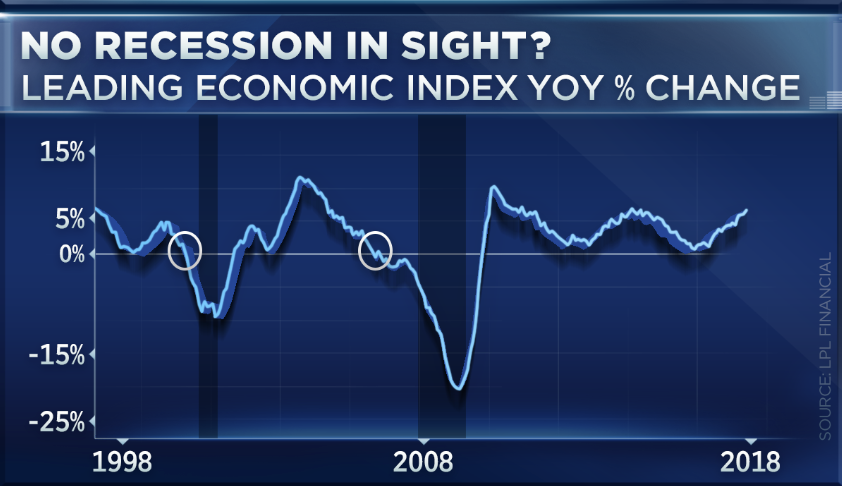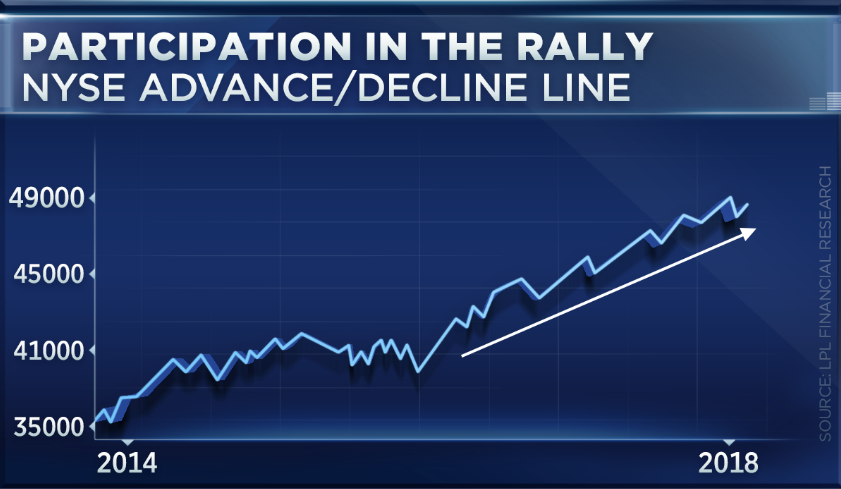The bull market turns nine years old this week. It could live to see double digits, says one market veteran.
“Bull markets do not die of old age. They die of excess — overspending, overleverage, overconfidence,” Ryan Detrick, senior market strategist at LPL Financial, told CNBC’s “Trading Nation” on Tuesday. “We look at these things, and we simply aren’t seeing the same levels of overs or excesses that we’ve seen in the past at major market peaks.”
The current bull market marks its ninth birthday on March 9. On that day in 2009, the benchmark index hit a low of 676.53 in what would be the bottom of the financial crisis’s market sell-off. Since then, it has surged 302 percent, marking the second-longest and second-largest bull market run in its history. It has only been beaten by the bull market that stretched through the 1990s.
Two indicators suggest to Detrick that this bull market could continue through to its 10th anniversary. The first, the leading economic indicators index, supports the likelihood of growth in the economy in coming months. That forward-looking economic measure rose 6.2 percent year over year in January, its best increase since July 2014.
“Historically when that goes negative year over year we’ve seen a recession 14 months later,” said Detrick. “We’re nowhere near seeing a recession when you look at that one particular indicator.”
The Conference Board’s LEI, which measures 10 key data points, rose for the third month in a row in January. The index tracks economic elements such as unemployment, building permits and stock prices.

Detrick’s second indicator, the NYSE Advance/Decline Line, also suggests that there is life in this bull run. For one, the level of participation in the market rally, illustrated by how many stocks are advancing compared with declining, is currently broad. Second, there are no signs of a breakdown in the measure, which historically occurs ahead of market peaks.

“There’s a really good underpinning with the economics and, on the technical front, broad participation,” said Detrick. “Those things again suggest to us that this bull market can survive and continue to flourish here.”
History is also on Detrick’s side. According to his calculations, since 1950, if the S&P 500 rises by 5 percent or more in January, the full year has been positive every single time. The index increased 5.6 percent in January. Detrick remains confident that pattern could play out again even after the S&P 500 dropped nearly 4 percent in February.
“That good start to the year very well could mean potentially double-digit gains when we’re all said and done, and that’s what we’re looking for at LPL Research this year,” he said.
The S&P 500 is clinging on to its year-to-date gains after extreme swings in February. Since the start of 2018, the index has increased 1.5 percent. If those levels remain, it would mark the S&P 500’s smallest quarterly increase since the first quarter of 2016.
The Dow Jones industrial average has also been hit hard by recent volatility. The blue-chip index has risen 0.7 percent so far this year and is on track for its worst quarterly performance since the third quarter of 2015.
 EU News Digest Latest News & Updates
EU News Digest Latest News & Updates



